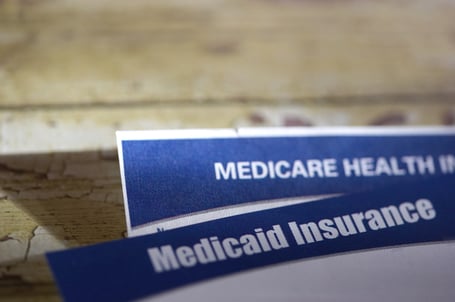School Guide to Expanding Medicaid Reimbursements for Special Education and Other Health and Behavioral Services
|
NOTE: New Guide Just Released to Help Schools Give Care to Children Covered by Medicaid
Is your school or district doing all it can to take advantage of these new funds? Any eligible service you are not currently billing for is money lost. The Centers for Medicare & Medicaid Services (CMS) just released Delivering Service in School-Based Settings: A Comprehensive Guide to Medicaid Services and Administrative Claiming on May 18, 2023.
CMS has also released an informational bulletin for more information
Our guide below provides an overview of what is covered and easy next steps on how to expand your Medicaid billing for many school-based services including ABA therapy, physical therapy, occupational therapy, speech pathology or speech therapy services, psychological counseling, physician and nursing services, eligible transportation services, audiological services, personal care services, vision and hearing services, and teletherapy. |
Table of Contents
- Introduction
- Medicaid Funding for School Special Education and Health and Behavioral Services
- State Medicaid Plans
- What Services Are Covered?
- What Providers Are Covered?
- What Support Systems Are There? The Role of LEAs and Vendors
- How does School-Based Medicaid Claiming Work?
- What Documentation Is Needed for Reimbursement?
- What is the Best Process to Use for Getting Parental Consent?
- What Should My Next Step Be for My State?
- New Reimbursement Information for Teletherapy
Introduction
When children’s physical and behavioral health needs are not addressed it impacts their ability to learn. After decades of decline, the rate of uninsured children increased significantly between 2018 and 2019 to an estimated 5.7% of children in the U.S. who are uninsured. While current figures from 2021 are not available, we know this number has grown significantly since the COVID-19 pandemic due to job loss, illness, and parental death.
Many schools struggle to fund health services for children in need. The federal Medicaid program provides school districts with partial reimbursement for monies spent on an increasing number of health and behavioral services provided in schools. State Medicaid plans are now being revised to expand what services can be reimbursed including new coverage for teletherapy services that have become widely used and accepted since the COVID-19 pandemic.
The main focus for schools should be learning. Participating in Medicaid reimbursement programs needs to be made as simple as possible for school leaders and administrators so that they can focus more on education and less on obtaining Medicaid program reimbursements.
The goal of this guide is to provide an overview and next steps for school leaders and administrators on how to take full advantage of expanding state Medicaid reimbursement programs. For school leaders in states that have been slow to expand their coverage for school-based services, the Health Schools Campaign provides resources and best practices for helping your state move forward with its programs.
Medicaid Funding for School Special Education and Health and Behavioral Services
Close to 80% of children who receive behavioral services get these services at school. Medicaid funding provides schools with a way to cover some of these costs. In 2014, the Centers for Medicare and Medicaid Services (CMS) expanded coverage and clearly spelled out which services can be reimbursed in schools. This allows schools to expand their Medicaid reimbursement programs to cover more students and bring in more federal funding to provide services to those students in need.
Medicaid’s core benefit for children from low-income families covers Early and Periodic Screening, Diagnostic, and Treatment (EPSDT), which includes:
- Early - Assess and identify problems early
- Periodic - Check children’s health at age-appropriate times
- Screening - To detect potential health issues
- Diagnostic - To be provided when risk is indicated
- Treatment - To improve or correct health problems identified
Medicaid provides funding in almost all states for school health services, and since 1988 has reimbursed states for medically necessary services provided in schools for children with an Individualized Education Plan (IEP). Schools are required to provide any services listed on the IEP regardless of whether they file for Medicaid reimbursement.
Medicaid reimbursement is available for covered services even when care is provided by providers that do not charge individuals for the service (this is referred to as the free care policy). What services are covered varies by state. The free care policy change is complicated but essentially allows schools to bill for needed health and behavioral services that are not part of a student’s IEP plan.
Medicaid funding is available only when all of the following elements are satisfied:
- The individual is a Medicaid beneficiary.
- The service is a covered Medicaid service under the approved state plan.
- The provider is a Medicaid-participating provider and meets qualification requirements.
- The state plan has a payment plan that sets rates that are efficient and support quality of care.
- Third party liability (TPL) requirements are met.
- Medicaid payment does not duplicate other payments for the same service.
- The state and provider maintain auditable documentation.
- The state conducts appropriate financial oversight of provider billing practices.

State Medicaid Plans
Each State’s Medicaid plan is different, so the first step in developing your reimbursement plan for your school or district is to consult this State-by-State School Guide for Medicaid Reimbursement. These state plans indicate who gets covered, what services are covered, and who is eligible to be a provider. Medicaid will pay for any medically necessary services as long as federal, state, and local rules are followed.
Many states provide reimbursement services through their Local Education Agencies (LEAs) and others use managed care arrangements (private health insurance). CMS reimburses states for a portion of the services that are billed, and each state then passes some of these funds on to schools and districts.
Note: Increase the number of eligible services that are billed to Medicaid by your school or district and you get back more money at the federal level from CMS. Any eligible services that are not billed for will be money lost to your school and state.
What Services Are Covered?
Medicaid will reimburse schools for providing direct medical/health-related services to Medicaid-eligible children and for performing administrative duties to support the state plan. Medicaid allows school districts to bill for certain medically necessary services provided to Medicaid-eligible special education students who have IEPs under the Individuals with Disabilities Education Act (IDEA) and has now expanded to services for all Medicaid-enrolled students.
These eligible services vary from state to state and are intended to recover some of the costs of delivering federally mandated health-related services. Medicaid payments to schools can also cover outreach and enrollment activities and other school-based Medicaid administrative activities such as holding a meeting with staff and parents to discuss a treatment option or transporting a child to a specialist.
In 2014, Medicaid reimbursement was greatly expanded for school-based health services. This change provides states with more flexibility by allowing school districts to bill Medicaid for health services delivered to all Medicaid-enrolled students, not just those with IEPs. As of 2020, ten states—Connecticut, Kentucky, Louisiana, Massachusetts, Michigan, Missouri, Nevada, New Hampshire, North Carolina, and South Carolina—have expanded their school-based Medicaid programs and many more, such as Florida, California, and Oregon are jumping on board. For a list providing live updates see: State Efforts to Implement the Free Care Policy Reversal.
Note: For autistic children, most state Medicaid agencies now include in their state plans coverage of Applied Behavior Analysis (ABA) services, considered the gold standard for treatment, when medically necessary and provided by qualified Medicaid providers.
While not covered by all states, services most often covered are the following:
- ABA therapy
- physical therapy
- occupational therapy
- speech pathology or therapy services
- psychological counseling
- physician and nursing services
- eligible transportation services
- audiological services
- personal care services
- vision services
- hearing services
- relevant administrative costs
[See Appendix A for specific examples]
What Providers Are Covered?
Each state Medicaid Plan lists the eligible providers and their scope of services. These providers may include LEA employees, school nurses, counselors, school psychologists, speech-language pathologists, physical therapists, and occupational therapists. The state education department credentials providers who are employed by schools and the credential is specific to the school setting, so in some states this may mean that, to be reimbursed, the providers cannot serve students in other settings (again, this may vary by state). Also, CMS, in some cases, requires a qualified provider -- such as a psychologist -- to also meet federal licensing requirements. To find out the requirements for your state, see the State-by-State School Guide for Medicaid Reimbursement.
What Support Systems Are There? The Role of LEAs and Vendors
For many school districts, Local Education Agencies (LEAs) have created an infrastructure to link school health services with Medicaid, including online case management and data collection. Vendors can also be a key resource for information and support for billing and data sharing between agencies.
Specialists at the State and LEAs and other state program infrastructure can provide a great deal of support in dealing with the complexities of Medicaid reimbursement for school services. School district administrators do not need to know every detail about how to claim reimbursements. CMS also provides two guides that walk states through the process: a technical assistance guide and an administrative claiming guide. These guides are dated (1997 and 2003), but remain the “go-to” for federal guidance on making reimbursement claims.
How does School-Based Medicaid Claiming Work?
School-based Medicaid claiming programs allow school districts to seek reimbursement in three ways:
-
Fee-for-service (FFS) Billing
FFS Billing (also called Direct Service Billing) involves claiming for individual health or therapy sessions in school settings. Typically schools bundle claims and submit these monthly or quarterly and reimbursement is provided within a month of submission. Rates vary greatly by state, for example, Florida pays $3.74 for 15 minutes of speech therapy and Virginia pays $31.91. (Neither of these cover 100% of the cost to the school). -
School-Based Administrative Claiming (SBAC)
SBAC provides districts with a way to get reimbursement for Medicaid administrative outreach and support activities. These claims use a quarterly time study that uses codes for different types of professional activities and the Random Moment Time Study to determine what percentage of time is spent on these services. Not a simple process to set up, but once created this can save school districts money spent determining precise amounts of time spent on these services. Direct therapy costs are not included in SBAC reimbursements. -
Cost Reconciliation
Cost Reconciliation, sometimes called Cost Settlement, is done annually to provide districts with additional funds for direct therapy when the amount spent by the district exceeds what was reimbursed under FFS billing. Not all states provide this option. Because so much labor is involved in reviewing and auditing these submissions, payment can take as long as two years after services are provided. The Random Moment Time Study is used for this process and then the district must report on total yearly costs for personnel and district monies spent on direct therapy for Medicaid-eligible students.

What Documentation Is Needed for Reimbursement?
Documentation needed for Medicaid reimbursement by schools for services delivered is similar to what medical providers submit to a health plan when billing for their time. Schools must document what services were delivered, the duration, and any notes about the service or treatment. The school is also obligated to document that the service meets the state’s definition of medically necessary. It cannot be assumed that Medicaid will reimburse for all services included in an IEP. The school is legally obligated to deliver IEP-required services, but not all of these services are automatically covered by Medicaid. This means that sometimes it is necessary to include medical documentation that indicates medical necessity according to the rules of the specific state because being on the IEP plan may not be sufficient.
[See Appendix B for a sample documentation form for school-based Medicaid services in Massachusetts].
What is the Best Process to Use for Getting Parental Consent?
 Parental consent is required for students under 18 to be treated and to receive Medicaid reimbursement. The process for getting parental consent also varies by state.
Parental consent is required for students under 18 to be treated and to receive Medicaid reimbursement. The process for getting parental consent also varies by state.
The State of Massachusetts is considered a “best practices” model for how to effectively collect parental consent. As part of their school-based Medicaid expansion program, the state requires all parents to submit new forms and has provided guidance to LEAs on how and why these consent forms are essential for ramping up more effective Medicaid reimbursement programs.
These best practices for the state LEAs include recommendations that:
- “LEAs may use the new consent form at IEP or other health plan meetings. During the meeting, the LEA can ask if parents/guardians are willing to complete the form naming all children in the family.
- LEAs may include the new consent form with other required information sent home with students pursuant to Title I, information about free and/or reduced lunch applications, or other similar communication.
- LEAs may include the form in annual “back to school” packets for families that are understood to have MassHealth (Medicaid), including any family that participates in the free lunch program.
- LEAs may use Medicaid Eligibility Matching response file information made available to school districts to identify students who are enrolled in MassHealth.
- LEAs may use the Provider Online Service Center (POSC) individual eligibility inquiry function to determine if a student is enrolled in MassHealth prior to obtaining parental consent.”
What Should My Next Step Be for My State?
- Go directly to your state in our State-by-State School Guide for Medicaid Reimbursement.
- Determine who is the best resource for your school or district to rely on. A local or state educational services agency, or an outside vendor who assists with administrative functions for collecting claims and billing in coordination with the state Medicaid department.
- Consult the State Efforts to Implement the Free Care Policy Reversal to get up-to-date information about your state’s expansion efforts and what is now covered.
New Reimbursement Information for Teletherapy
In the spring of 2021, many states expanded Medicaid reimbursement rules for Teletherapy. During the COVID-19 pandemic, students’ access to school-based physical and behavioral services shifted from in-person to remote online learning. As schools adapted to this new way of delivering services, many state policies were revised to allow Medicaid to reimburse school-provided telehealth services in order to meet federal requirements to provide services to students with disabilities. A guide by the National Academy for State Health Policy provides a map indicating which states now offer Medicaid reimbursement for services provided via teletherapy platforms.
For some states, this service was limited to services provided during the COVID-19 pandemic, but for other states, teletherapy services will continue to be covered. In particular, synchronous (in real-time) audio and video services delivered are eligible for reimbursement. Some states also cover asynchronous services.
Due to privacy concerns, school-based providers need to adhere to strict guidelines. Using a secure system, such as the Stages Learning Line platform, will ensure that privacy requirements are met. There is a great deal of support for Medicaid reimbursement for telepractices. The American Speech and Hearing Association (“ASHA “) recently came out with a document supporting the effectiveness of providing this type of service delivery noting that data are showing positive outcomes as well as an increase in attendance and participation.
Note: Because specialists, such as Speech Language Pathologists, do not need to provide services in person, many states waived rules for residency and licensing for remote services to children during the pandemic. See, for example, ASHA’s state-by-state guide that tracked in real-time the emergency or temporary licensure exemptions or allowances considered for out-of-state providers.
For behavior analysts (including RBTs, BCaBAs, BCBAs, and BCBA-Ds, the Behavior Analyst Certification Board compiled a list of links to each state’s licensure requirements and information about providing behavioral health/ABA services across state lines during the COVID-19 pandemic.
Appendix A:
As one example, California covers the following:
|
• Health and Mental Health Evaluation and Education Assessments |
• Nursing Services |
|
• Nutrition Services |
• Occupational Therapy |
|
• Optometry Services |
• Orientation and Mobility |
|
• Physical Therapy |
• Physician Services |
|
• Psychology and Counseling |
• Respiratory Care |
|
• School Health Aide Services |
• Specialized Medical Transportation |
|
• Speech Therapy |
• Targeted Case Management |
Specific to autistic students in California, services covered include: “all medically necessary behavioral health treatment (BHT) for eligible beneficiaries under 21 years of age. This may include autistic children... as well as children for whom a physician or psychologist determines it is medically necessary... BHT services include ... ABA and a variety of other behavioral interventions that have been identified as evidence-based approaches that prevent or minimize the adverse effects of behaviors that interfere with learning and social interaction, and promote...the functioning of a beneficiary. Examples of BHT services include behavioral interventions, cognitive behavioral intervention, comprehensive behavioral treatment, language training, modeling, natural teaching strategies, parent/guardian training, peer training, pivotal response training, schedules, scripting, self-management, social skills package, and story-based interventions.3
Appendix B:
A sample documentation form for school-based Medicaid services in Massachusetts indicates that the following information needs to be documented:
|
School-Based Medicaid Program Services Documentation Form School district name: This line captures the name of the school district where services are provided Provider no.: This line indicates the provider number used to bill the Medicaid program Service period, year: This line indicates the evaluation period during which services are provided. This form is to be completed monthly. Student name: This line indicates the student’s complete name and date of birth Student’s MassHealth ID: This line includes the student’s MassHealth identification number Date: This column indicates the date a health-related service is provided to the student. This should be completed every time a health-related service is delivered. Activity/Procedure Note: In this column, the provider should write a description of the service provided to the student on that date. This must document the extent and duration of the medical service provided. Individual or Group: This column indicates if the service was delivered to the student on an individual basis (I), or in a group setting (G). Service Time: This column captures the quantity of service provided to the child. This should be recorded as an amount of time (e.g., 20 minutes). This can capture the cumulative time the provider spent delivering services over the course of the day. Signatures: The signature of the medical professional authorizing services must comply with generally accepted standards for record-keeping within the applicable provider type, as may be found in laws and regulations of the relevant board of registration. |
This guide was based, in part, on the following resources:
National Academy for State Health Policy. States Expand Medicaid Reimbursement of School-Based Telehealth Services. Updated May 5, 2021. https://www.nashp.org/states-expand-medicaid-reimbursement-of-school-based-telehealth-services/ (see chart)
ASHA Wire. Medicaid Services in Schools Will Look Different This Fall https://leader.pubs.asha.org/do/10.1044/leader.BML.25082020.32/full/?fbclid=IwAR0DXlGztH9uLk8uxu3dWDUzgbnfy4osV6Tn7S2ziA7oludL1i8rULrRE_8
Health Schools Campaign. Schools Are Key To Improving Children’s Health: How States Can Leverage Medicaid Funds to Expand School-Based Health Services January 2020. https://healthyschoolscampaign.org/wp-content/uploads/2020/01/Policy-Brief-1-28-20.pdf
Center for Medicaid and Medicare Services (CMS). 2014 Letter. Re: Medicaid Payment for Services Provided without Charge (Free Care) https://www.medicaid.gov/federal-policy-guidance/downloads/smd-medicaid-payment-for-services-provided-without-charge-free-care.pdf
Frontline Education. School-Based Medicaid 101: Enhancing Medicaid Reimbursements for Schools https://www.frontlineeducation.com/blog/blog-maximizing-school-based-medicaid-reimbursements/
AASA Medicaid Report. Structural Inefficiencies in the School-Based Medicaid Program Disadvantage Small and Rural Districts and Students https://www.aasa.org/uploadedFiles/Policy_and_Advocacy/Resources/AASA_Medicaid_Report_FINAL.pdf
Health Schools Campaign. Opportunity: Expanding School-Based Medicaid Programs Through The “Free Care” Rule. https://healthyschoolscampaign.org/dev/wp-content/uploads/2020/01/Expanding-SB-Medicaid-Programs-Through-the-FC-Rule.pdf
Footnotes
2. See: https://www.frontlineeducation.com/blog/blog-maximizing-school-based-medicaid-reimbursements/
3. See: https://www.dhcs.ca.gov/services/medi-cal/Pages/BehavioralHealthTreatment.aspx

L.F. Stebbins, M.Ed. M.L.I.S.
L.F. Stebbins has more than twenty-five years of experience in higher education with a background in library and information science, instructional design, research, and teaching. She has an M.Ed. from the Technology Innovation & Education Program at the Harvard Graduate School of Education and a Masters in Information Science from Simmons College. For twenty years she created and led media literacy and research skills programs for students and faculty at Brandeis University. Currently she is the Director at research4Ed.com and the Director for Research at Consulting Services for Education (CS4Ed). For more about Leslie visit LeslieStebbins.com.




